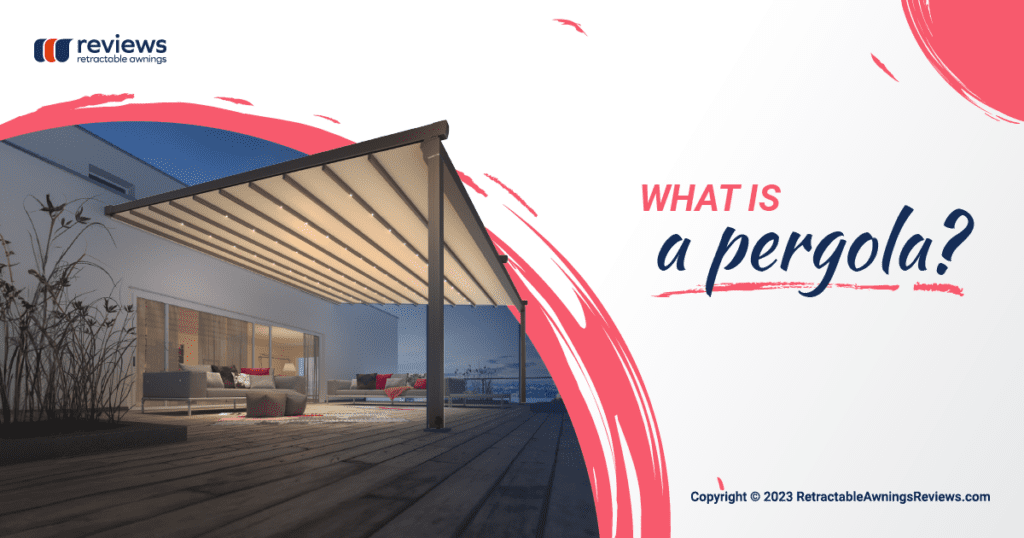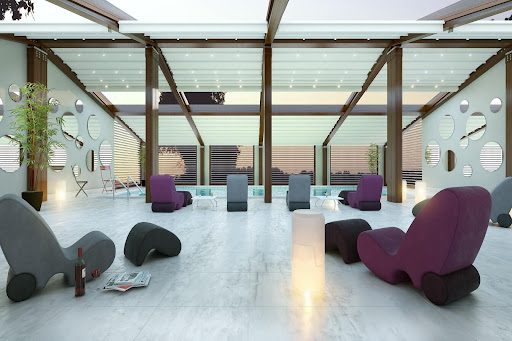
What is a pergola? You may have seen pergolas and other outdoor structures in picturesque gardens before, or you’re curious to explore possible ways to improve your outdoor living area.
Pergolas have massively grown in popularity over the past decade. If you are wondering what the purpose of pergola covers and sheltered outdoor living spaces for your home or business is, you’ve come to the right place.
Today we’ll cover everything you need to know about pergolas, including their origin, purpose, benefits, types, installation and, most importantly – how to get the right one for you.
The origin of the pergola
The term “pergola” originates from the hot deserts of the Egyptian lands, where the first one is said to have served as a gate entrance and dates back as early as 1400 BC. The wealthiest among the Ancient Romans also constructed pergolas, which they referred to as “peristyles.”
However, don’t start fantasizing about modern retractable shade canopies. People built these ancient pergolas of stone, brick and wood and grew hanging plants to create shade and hide away from the scorching sun.
Much later, in the Italian Renaissance, creative architects began experimenting with outdoor space structures while maintaining the originality and authenticity of the Roman imperial villas. They designed pergolas that formed a long linear structure creating outdoor walkways where people could walk in the shade.
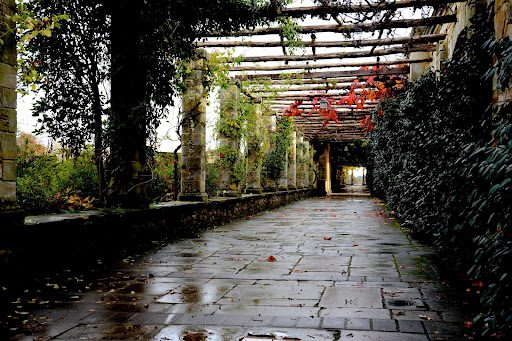
As the original pergola had an open roof, people used it to support vines and beautiful decorative climbing plants to prevent direct sunlight from reaching the garden pathway.
Below I’ve listed a few options for such plants:
- Climbing rose bushes
- Climbing vines
- Virginia creeper
- Dutchman’s pipe
Today, people are getting even more creative with their backyard space, creating various structures such as garden arbors, gazebos and even louvered pergolas. Each type of outdoor structure combines different materials and details to suit individual requirements and can vary significantly in appearance and design.
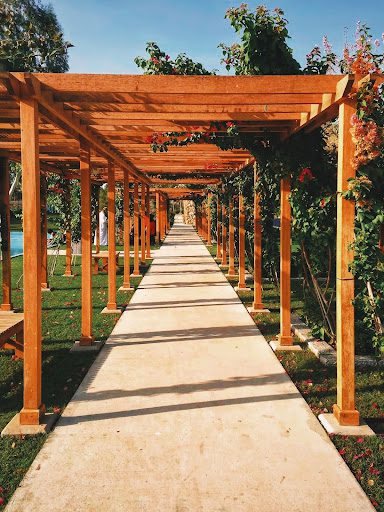
What is the purpose of a pergola?
Now that we have established the ancient history and origins of the pergola, we can move on to the more modern versions.
A typical freestanding pergola is an outdoor structure supported by four posts. It could be installed by residential and business owners in a backyard, patio, deck, near a pool area or any available outdoor space. On the other hand, an attached or non-freestanding pergola requires structural anchoring to a building and two or more support columns, depending on the size.
The original purpose of the Roman pergola was to offer protection from the intense sun, add aesthetic beauty and increase the privacy of the wealthy. Nowadays, its purpose is not much different, although there have been significant changes in production materials, complexity, quality and features.
Today, the market offers fully closed roof pergolas for maximum shade instead of an open roofing grid covered with hanging plants. Such outdoor structures provide superior sun, heat, glare and damaging UV ray protection.
Thanks to a pergola cover, you can achieve a cozy and pleasant ambiance on a balcony or in a garden. Typically the space between the support columns is open. Therefore, you get the restful feeling of having a roof over your head and being in the open outdoors with an unobstructed view.
Depending on their design and production materials, you can use modern pergola covers for various purposes:
- To provide complete shade for your deck or backyard.
- To protect your outdoor furniture from decaying.
- To add privacy to your residence or business space.
- To add curb appeal and impress or attract passersby.
- To beautify your outdoor living space.
- To cover an outdoor kitchen, hot tub or pool.
- To protect yourself from light rain, heavy rain, or snow.
- To automate your entire residential system.
Benefits
One of the greatest benefits of pergola kits is their diversity and unlimited customization opportunities. You can find various pergolas for your deck or patio that differ in production materials, size, shape and colors.
This incredible variety allows you to create the perfect place to relax in your garden or balcony during the hottest months; meanwhile, you get extra outdoor living space that enlarges your property. But let’s look at the pergola benefits more closely.
Open roof, closed roof or a mix
On the one hand, there are pergolas with open roofs that only use cross beams built in a crisscross pattern at the top and some decorative plants. Such structures provide some shade, but they are not functional in rainy weather.
On the other hand, you have fixed solid roof pergolas (e.g., a pavilion) that shelter the area from various weather conditions, like sun, rain and snow.
And there is the third, most practical option – pergolas with a retractable canopy or louvered roof. The primary difference between this and the rest of the options is the ability to retract and extend the roof whenever you see fit. This way, you can create more shade for the summer months or leave the area open to enjoy a warm autumn day.
Remember that the more functions and features you get, the higher the pergola cost.
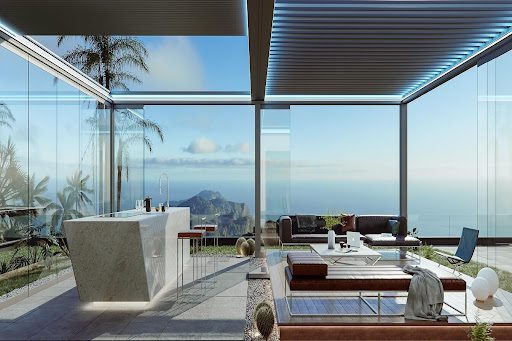
Countless customization options
Outdoor patio pergolas give you countless opportunities for customization and personalization of the product, so it fits your exact needs and expectations.
Starting with the walls, you can completely enclose the area by adding retractable side screens, sliding glass doors or transparent zip screens. Another possibility is to leave the space open and enjoy the fresh breeze at all times.
You can also purchase a custom pergola with precise measurements to fit the outdoor space you want to upgrade. You can also upgrade it with additional gadgets: LED lights, heating appliances, speakers, ceiling fans – all of these will make your backyard cozy and romantic and will make it the centerpiece of your home or business.
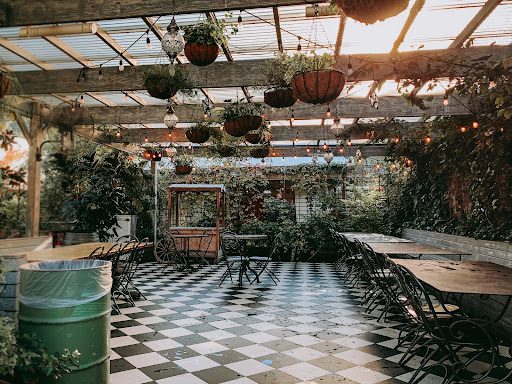
Protection from various weather elements
Of course, when you think of a pergola, you imagine lying in the cool shade in summer. However, the structure provides more opportunities than just UV-ray and sun protection. Nowadays, you can choose from countless pergola offers that can shelter your outdoor space from wind, light rain, heavy rain, snow and even hail.
Utilization possibilities
When you start to think about what you want to use your pergola for, you’ll realize that the possibilities are endless:
- Birthday parties
- Weddings
- Outdoor cinema
- Family or alone time
- Cozy game night with friends
- Yoga and a Zen corner
- Dining area
- Cafe Lounge
- Poolside shade
- Beach bar
Of course, pergola use dramatically varies depending on what you need it for – residential or commercial purposes. The choice is all yours.
Lots of mounting options
You can assemble various pergola types, including retractable shade canopies, easily, quickly, and in different ways:
- Over an existing patio roof
- Over a pool or a hot tub
- On a raised floor
- Against a wall
- Completely freestanding
You can install a gazebo if you want to build a decorative structure and love retro designs. Gazebos are further distinguished from most pergolas by having a raised floor and an unmistakable rounded shape.
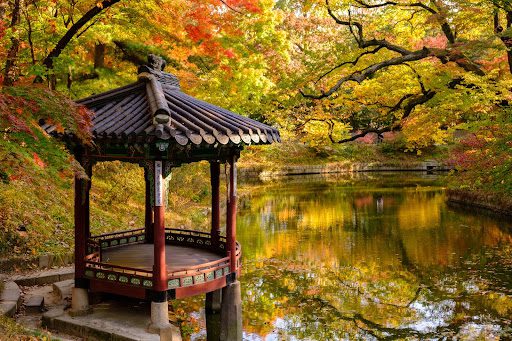
Types of pergola designs
You can choose among many pergola designs to perfectly match your home’s or business’ style, either classic or modern. The traditional pergola design includes wood, which, although very appealing, requires extra maintenance efforts.
On the other hand, modern designs rely on aluminum and rust-proof coatings’ lightweight qualities and durability as a precondition for low maintenance. They’re easy to assemble, incredibly durable and highly resistant to weather conditions.
Brick pergolas
Although they certainly look appealing, brick pergolas are not very functional. They are an expensive option that is challenging to assemble and does not provide more benefits than other designs. Bricks lack flexibility and are more of a permanent solution.
Wooden pergolas
This type of pergola is very appealing and combines perfectly with the greenery of your outdoor area. You can easily decorate and paint it, but natural materials have disadvantages. You’ll need to treat the wood with unique products periodically to prevent moisture buildup, cracking and the spread of moths and bugs.
A vacuum-treated and pressure-treated wood shows significantly higher resistance qualities and a longer lifespan. Some vendors offer wooden pergolas with state-of-the-art integrated gutters for supreme drainage and improved durability.
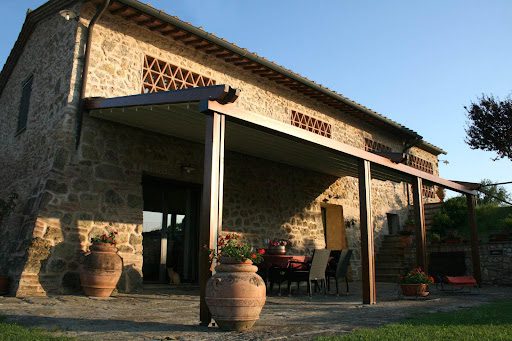
Cane pergolas
They can be made from bamboo, reed, and other materials. However, these open structures will need to be renovated periodically. In addition, reeds shed tiny fibers, so cleaning the area under the pergola can be tedious.
Retractable pergolas
Certainly, this is the most innovative and recommended option available today. Retractable pergolas are highly functional and customizable structures typically made of aluminum frames, heavy-duty fabric covers, or louvered roofs.
Aesthetically, retractable pergola canopies are the most attractive solutions on the market. These pergolas are the ultimate choice for outdoor living in residential, institutional and commercial properties and gardens. All you have to do is pick a model and customize finishing touches that suit your style, so your home or business will radiate style.
Are they easy to install?
Building a pergola is a fun and rewarding project that will increase your outdoor area’s usability. Depending on the type of pergola design, the installation process can range from easy to quite challenging and require professional help.
An open-roof pergola is easier to build and does not require as many materials. An easy structure like this can be built on a weekend, while a more complicated one might take a week or two. If you decide to invest in a retractable pergola, it’s advisable to use professional installation services to ensure it’s done correctly.
There are a few things to consider before you purchase and install your pergola:
- Time of year – consider during which season you want to install your pergola. Usually, it’s wise to buy and install a retractable pergola or awning right before spring begins.
- Placement of the structure – ensure there’s enough space for your pergola and that it will be located conveniently for maximum shade and privacy
- Production materials – consider the most suitable materials while considering the weather conditions in your local area. Another consideration is cost and construction difficulty.
- Size and dimensions – you’ve already decided where to place the pergola, and now it’s time to think about its precise measurements and dimensions.
- Type of roof – consider the advantages and disadvantages of each type (solid, open or retractable) and choose the right one for you.
If you are unsure about any of these details, it’s always a sound idea to talk with an expert from a professional company before you start. They will give you advice on what will suit your situation best and help you avoid any expensive and time-consuming mistakes.
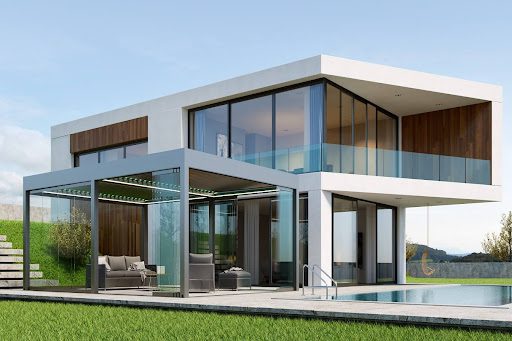
How to get the right pergola for you?
Choosing the right pergola for your home or business can be a difficult task, as there are many factors that you need to take into account. The options are vast, and so are the number of styles, materials and designs you can pick.
There are a few things to consider when choosing the right pergola:
- Sun path – calculate the sun path and the outdoor area you want to cover. Ensure there won’t be any surprises once the pergola is installed.
- Size – if you want to create a comfortable space with enough room for your favorite furnishings and your customers, friends or family, you will need roughly around 200 sq ft available.
- Location – you can build a freestanding structure, or you can attach your pergola to an exterior wall of a building. This depends on the available space in your patio or backyard.
- Materials – think about strong autumn winds, rainy days, summer storms and heavy snow and choose the production materials that will give you the most comfort throughout all seasons.
For example, an aluminum structure easily withstands any weather changes. Combined with quality powder coating and numerous color possibilities, metal becomes one of the most preferred materials for the production of outdoor pergolas.
A wooden pergola is a classic choice because wood creates a cozy ambiance, warmth, and visual calmness. For it to remain in pristine condition, you have to regularly apply protective wax and revarnish certain areas. Maintenance requirements’ costs are something to consider before choosing a pergola.
Vinyl pergolas have an original look and are easy to maintain. However, they’re not famous for their sun and wind resistance like PVC materials. As long as it’s supplied with a drainage system, PVC exhibits excellent performance in harsh weather conditions. Bioclimatic retractable louvered roofs remain unbeatable when discussing heavy loads like accumulated snow.
So, what is a pergola?
A pergola is a stunning and cozy outdoor construction traditionally used to cover walkways or seating areas. It can be completely freestanding or semi-attached to a building.
A pergola creates an outdoor place where you can enjoy some alone time by grabbing that book you’ve been meaning to read since last year. You can also invite friends and family for a barbecue and a laugh. Or it could be the favorite place for your customers. The pergola is not just a decoration for your backyard but a part of your home or business.
